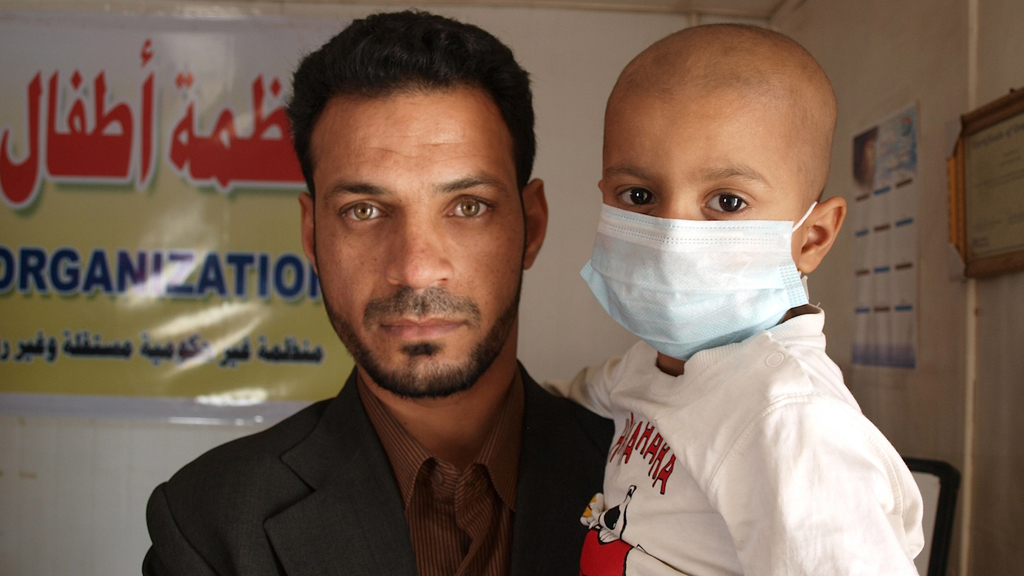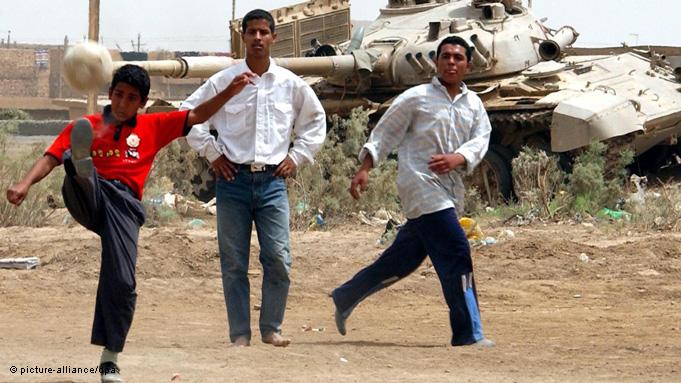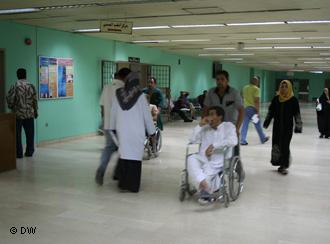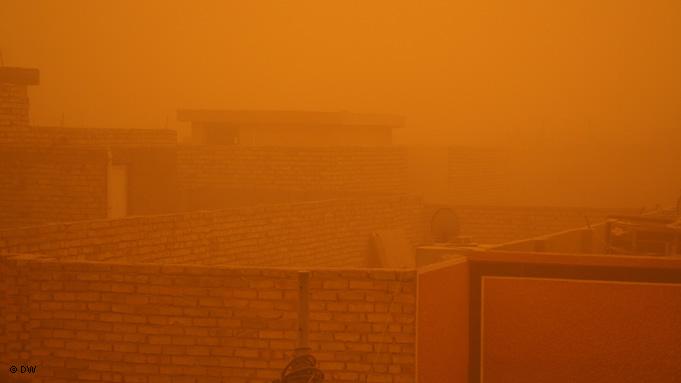Deadly Dust Falls in Silence

As violent sandstorms sweep across swathes of southern Iraq, the scene brings back memories of ten years ago. Along the Schatt al-Arab river, at the confluence of the Tigris and Euphrates, the palm fronds droop sadly. Particles of the flying dust find their way into the tiniest cracks in house walls. When American and British troops invaded Iraq on 20 March 2003 and captured Baghdad on 9 April, the Iraqis blamed the movement of the heavy coalition tanks for whipping up sand storms. Where the responsibility lies this time has yet to be established.
Forty kilometres south of Nasiriyah, on the Basra road, the evidence of war is still visible all around – and there was no shortage of wars under Saddam Hussein. Basra, more than any other city in Iraq, knows all about war: war against Iran, war against Kuwait and war against the Americans.
Even today, as one travels along the highway from Baghdad, the signs of battle are all too evident: burned out tanks, Humvees and armoured vehicles are scattered everywhere, conserved by the dry desert wind and covered by a thin layer of sand. Most are remnants of the fighting in 1991 when allied troops under US command drove the Iraqi army out of Kuwait. It was here in the south too, in the spring of 2003, that the Americans and British encountered the fiercest resistance. In other parts of the country, the Iraqi army surrendered almost without a fight. Basra has, however, to a certain extent been spared the violence of recent years that has ravaged the likes of Baghdad, Mosul or Kirkuk.

First studies
"This is the line marking the start of the area contaminated with uranium," a doctor from Basra tells me as we gaze upon the debris-strewn desert landscape. "From here all the way to the Gulf, radiation levels are high," he says, and cautions against getting any closer to the radioactive military vehicles. After all, these vehicles are the source of the radiation. Many people, it seems, did not realise the danger, and by the time they did, it was too late. It is only in the last two years that independent institutions have begun to publish irrefutable evidence of the contamination.
In November 2012, the Bulletin of Environmental Contamination and Toxicology in Heidelberg published a study that revealed that the number of congenital deformities in Basra had increased sevenfold between 1994 and 2003. Twenty-three out of every thousand live births exhibited abnormalities. The rate of neural tube defects (open back) in babies born in Basra, the study claimed, is unprecedented, and continues to rise, while cases of hydrocephalus (water on the brain) among newly borns are six times as high as in the United States.
DU ammunition is a sensitive issue in Iraq. Not every doctor in Basra is prepared to talk about it, even fewer to put their name to such talk. The discussion is made more difficult by the fact that radioactive contamination by armour-piercing uranium ammunition was a favourite propaganda topic of Saddam Hussein after the second Gulf War when George Bush Senior was in the White House. To date, no major newspaper in the US has published any articles on the genetic disorders in Fallujah, and not a great deal has been said about Basra either.
The British daily The Guardian, however, has criticised the silence of the West, calling it a moral failure, and citing chemist Chris Busby's claims that Basra has "the highest rate of genetic damage in any population ever studied". Busby has also co-authored two other studies on the topic. In December, the German news magazine Der Spiegel carried an article on what it referred to as the most comprehensive study of the topic thus far, conducted by the Royal Society of London in 2002. This study focused only on the potential threat to soldiers and came to the conclusion that the risk of radiation damage was "very low", as was the danger of long-term kidney damage from uranium dust.
Lead, mercury and carcinogenic soot clouds

There is no question that both American and British forces have used depleted uranium ammunition in Iraq. DU projectiles have alloys or cores that are made with "depleted", low-level radioactive uranium. The density of the core gives the projectiles such a high velocity that they are able to pierce the armour plating of tanks. Upon impact with their targets, a very fine DU dust is released.
Children playing near the wrecked tanks run the risk of absorbing the dust through their skin, for example, or getting it into their mouths or respiratory tracts. In 2002, a study carried out by the University of Bremen reported chromosomal changes in Gulf War veterans who had come into contact with depleted uranium ammunition. DU ammunition was used twice: once in the Basra area during the Second Gulf War in 1991 and then in the city itself in 2003, when British troops advanced from the west towards the airport. West Basra is the urban district with the highest rates of leukaemia among infants.
Uranium may be to blame for cancer and other abnormalities, but it is not the only dangerous substance to be found here. Toxic heavy metals such as lead and mercury, which are also used in the manufacture of munitions and bombs, represent further danger. "The bombardment of Al Basrah and Fallujah may have exacerbated public exposure to metals, possibly culminating in the current epidemic of birth defects," says the Heidelberg study.
In 2003, the Rumaila oil field near Basra was set alight and a cloud of soot laden with carcinogenic particles billowed over the city. In addition, over two million residents of Iraq's third largest city are constantly exposed to long-term environmental damage: contaminated soil and water and ever-worsening air pollution.

What happens to the oil revenues?
Basra is actually Iraq's richest city and could easily afford clean water, 24-hour electricity, good roads and a functioning rubbish collection system. But the reality of the situation in the city is very different. Two bridges, a new hospital and an additional university campus are the only things to have been constructed here in the last ten years. A "Sports City" has been under construction for years, though completion dates continue to come and go. Only the Sheraton Hotel has risen from the ashes, rebuilt after being successively bombed, plundered and burned.
Around the massive concrete blocks along the Shatt al-Arab embankment, mountains of rubbish rise amid lakes of sewage. The surrounding streets are cratered with giant potholes. Stray into the once lively Watan Street and things get even worse. Former cinemas, nightclubs and casinos lie empty and abandoned. The cheap shawarma fast food restaurants look desperately down at heel as do the mainly young male customers who tend to hang around in them.
One wonders what becomes of the money that Basra generates day by day. Every barrel of oil potentially puts another dollar into the city's coffers. Iraq is currently producing up to three million barrels of oil a day – more than at any time during the last 30 years. Basra produces the lion's share with 2.25 million barrels. The remainder comes from wells in Kirkuk in northern Iraq.
By way of explanation for the sorry state of Iraq's southern metropolis, people will tell you that it was Saddam Hussein who was responsible for letting Basra go downhill in the past. "Nowadays it is corruption that is holding up progress," explains a pharmacist in Watan Street. A report in the Iraqi newspaper Azzaman on the failure of a recent vote of no confidence in Sports and Youth Minister Jasim Jaafar lends credence to this claim. The minister had been accused of corruption in connection with the building of the "Sports City Basra" project. "They watch each other's backs," is the pharmacist's dry comment.
Birgit Svensson
© Qantara.de 2013
Translated from the German by Ron Walker
Editor: Aingeal Flanagan/Qantara.de